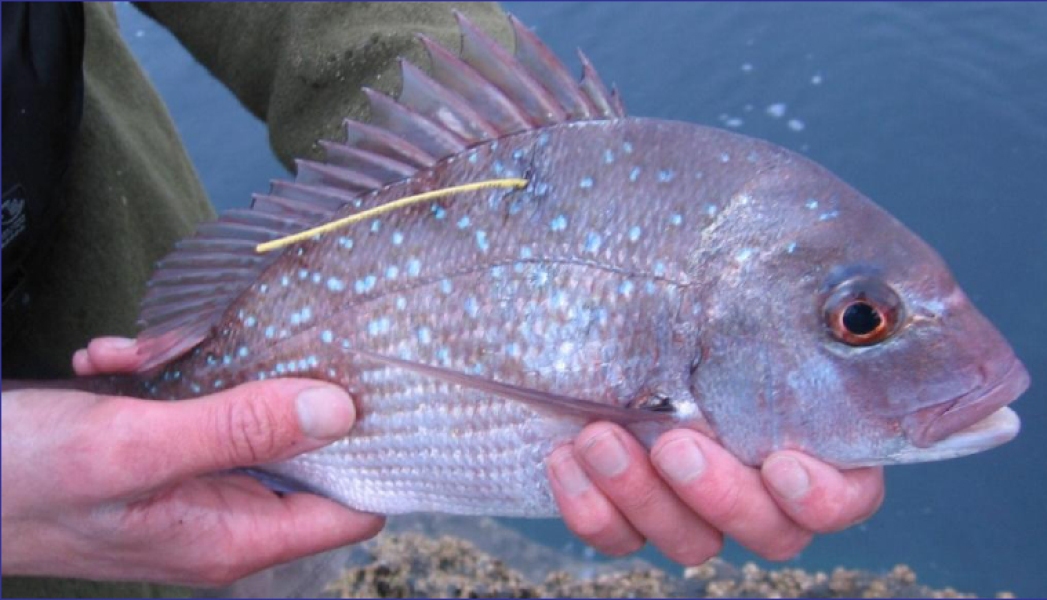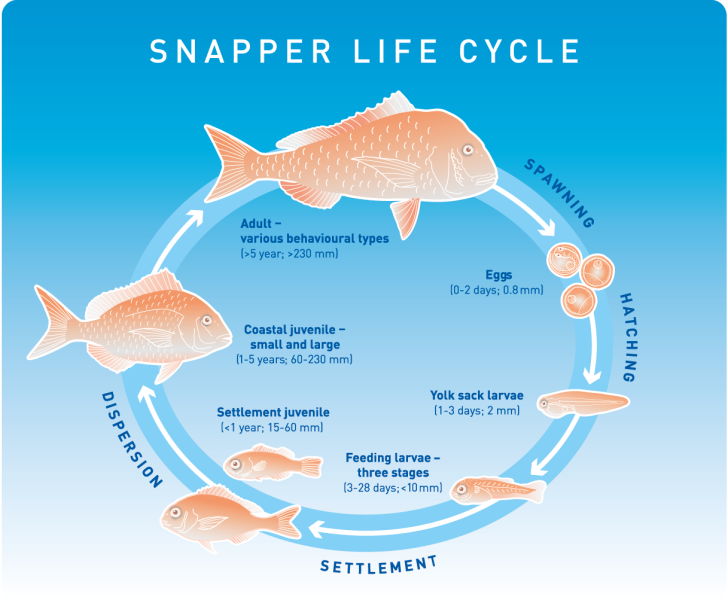NIWA has a number of projects that are allowing us to better understand the interaction between snapper and their environment over their life cycle.
More information on the snapper life cycle
Overview
Snapper (Pagrus auratus) an abundant and important fish species that occurs in the inshore waters around the northern half of New Zealand (see distribution map on the right). The same species also occurs at Norfolk Island and throughout the southern half of Australia. Similar species can be found in parts of Asia.
Snapper is an iconic fish that is of significant importance to New Zealand, and is important economically, culturally and ecologically.
Commercial economic value: Snapper is a valuable inshore commercial finfish species that has had a high commercial importance since the early 1900's.
Recreational value: Snapper are the finfish most often targeted by recreational fishers and recreational fishing often has a significant effect on the local economy.
Cultural significance: Snapper are highly valued by Māori, divers and non-extractive users.
Ecological value: Snapper are an important predator within the inshore waters of much of New Zealand and are a conspicuous and important part of the ecosystem. As an abundant predator, they also influence and modify the environment they live in.
Understanding the ecosystem influences on the life cycle of snapper
NIWA aims to improve our understanding of how the life cycle of snapper interacts with the environment around it, and how changes in that environment may change what's happening to our snapper stocks.
What are we doing?
NIWA gathered together scientists from around New Zealand, from a range of organisations, to map out and discuss the life cycle of snapper.
These scientists have combined their knowledge of snapper, its environment, and its life cycle to develop a more complete understanding of the influences of the wider environmental and human influences that may affect snapper populations. This information has been compiled and will be soon be published in the scientific literature.
Outcome
This work has shown that the life cycle of snapper is much more complex than previously believed. We know that the behaviour of snapper is complex, with the population containing individuals with different life history strategies and vastly different movement behaviours. Transitions between these behavioural modes can also occur, but these are still not well understood.
Additionally, we still don't know much about what happens to late stage larval and juvenile snapper immediately after settling*. We also know very little about some of the predators of snapper and how much influence they have on the population.
Post-settlement juvenile snapper are dependent on structured habitats in shallow water environments such as harbours and estuaries. Snapper in these habitats are vulnerable to increased sedimentation and nutrient loads derived from land-based sources. Increasing acidification in inshore waters, such as the Firth of Thames, may affect the development of the eggs and larvae, as well as the growth of juvenile snapper.
The future effects of climate variability and climate change may also result in altered wind-driven mixing, ocean current regimes and upwelling. These sorts of changes can alter the structure of the pelagic food web. We know there is a link between the size of the annual cohorts and warmer water temperatures, so it is possible that changes in our climate may lead to increased numbers of juvenile snapper.
A summary of the snapper life cycle can be found here, or in the menu on the left hand side. It shows the different sub-stages and environmental influences on snapper as they progress from eggs and larvae, to juveniles and then to adults.
This information is helping us to model the coastal environments and the ecosystem that snapper occupy, and is allowing researchers to concentrate their efforts on those parts of the life cycle we still do not fully understand.
With this information, scientists are now able to develop models that will enable us to simulate plausible scenarios for human use of our snapper resources and the surrounding ecosystem. This will allow us to better understand the consequences of actions across the entire ecosystem, taking into account the complex interactions between snapper, the system in which they live and the influences of key predators and prey on their sustainability.
* Settling is the process or time when larval snapper (which are drifting freely in the water column) become juveniles that are benthic (associated with the seabed).
Research team
The following people and organisations contributed to this work:
- NIWA: Darren Parsons, Bruce Hartill, Jeremy McKenzie, Ian Tuck, Malcolm Francis, Mark Morrison, Emma Jones, John Zeldis, Larry Paul (ex NIWA) and Alistair Dunn
- Ministry for Primary Industries: Martin Cryer
- University of Auckland: Agnes Le Port, Meredith Lowe, Craig Radford and Carina Sim-Smith
- University of Waikato: Phil Ross
- Auckland War Memorial Museum: Tom Trnski
- Stock Monitoring Services: Cameron Walsh
- Saltwater science: Natalie Usmar





